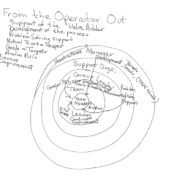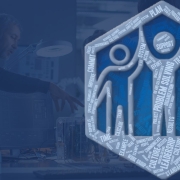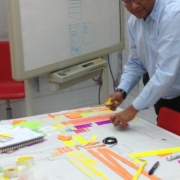The Role of HR in a Continuous Improvement Organization: Recognition
(Reposted by permission of the author from LinkedIn)
It is a fundamental need for members of an organization to want to know how they are doing. A Gallup Poll found that 33% of employees have not received positive feedback in their last seven days. In a study done by Sirota Consulting which surveyed 2.5 million employees from around the world, the finding was that 55% of those polled or interviewed said that being recognized is the greatest boost to performance. Consider this in terms of ordinary life for children today that expect a trophy of their participation in activities. It is easy to be confused when it comes to recognition. The great question is not “should we energize recognition activities?” but “how are we going to meet the expectations of all our members in the form of recognition without destroying personal accountability for good performance?”. Somehow we must find a way to give recognition while fortifying the message of accountability.
At the forefront of the requirement for recognition is the HR organization. They must ensure the implementation is consistent with values and operating principles, that it delivers value to the organization and the leadership is ready and capable to demonstrate commitment and proper behavior to all whom they interact. In this sense, recognition is a form of representation, as the leaders show the members they are understood and appreciated.
Accountability has become the aim of most organizations as they manage performance, absenteeism, discipline and career development. Achieving an environment where following the “best way we know how”, being on time and present, creating continuous improvement and long-term career-minded seems to be unobtainable. For the company to achieve inspired, creative and reliable performance is not just a dream but a requirement of long-term company viability. Every company must be high performing to be competitive and protect job security.
This raises the first question of what a high performing organization is. For a company to reach that standard, they must first be aware of their current level of performance, usually through metrics. These companies must remove roadblocks to performance and avoid low morale. Their leaders must be focused on the purpose of the organization and bring personal motivations to each member. The organization must learn from solving their problems and from their highest performing members. The expectations must be set at a high level and be aligned with the organization’s goals and targets. Relationships between management and members must be solid and proactive. Out of the relationships must come comfort and trust. In each leader, all members must see decision making that is reliable, valid and forward-thinking. All members must be willing to learn, listen with enthusiasm, be supportive of each other, placing no blame for problems and use fewer resources. Leaders must be clear about the future and assure that the organization does not get stuck in the status quo. Each member must improve every day and contribute to the growth and prosperity of the organization. All of this to be a high performing organization.
Common sense rules for recognizing individual interaction in an organization:
- Base recognition on goals attained and associated behavior
- Recognize improvement only from a standard
- Recognize individual and groups based on what they need or want
- No one size fits all
- Place recognition in the context of both short and mid-term goal achievement
- Compensation and recognition are different
- Every recognition should enhance accountability
- How the recognition is given is vital
These simple rules serve as guidelines. They are never the complete answer. This is because the aim of recognition is the enhancement of the system. This means that whatever is done must enhance the system of performance for the customer, culture and continuous improvement.
There are many ways to recognize a member or group. This list is not by any means complete. It does, however, point out an important fact that these ways and many others are available and few if any require a resource aside from the time taken to show up and be present for the member as you demonstrate both humility and gratitude.
- The strongest form of recognition is a request for help in solving problems.
- Feedback is personally given
- Positioning for future performance
- Recognize traits and behaviors
- Show the person a glimpse of the future
- Appeal to a person’s pride
- A simple thank you is the best form of recognition. It recognizes commitment.
- Demonstration of trust
- Recognize the impact on the team
- Simple hello, ask for help
- In expectations set at goal deployment time
Remember SMART (S= specific, M= measurable, A= accountable, R= relevant, T= timely) goals. At the basis of many of these ways is the establishment of goals and targets for the individual. The process to develop these, if done right, gives the individual comfort in knowing what they have to for their performance to benefit the organization. One trick is that the leader never tells the subordinate how to accomplish their goals. The leader delivers “what” has to happen and asks for a plan from the subordinate as to “how” the “what” will get done. For most organizations, improvement goals represent about 20% of their actions during the performance period. Reviewing these goals is a great time to recognize effort and effect and give signals about expectations. The accountability of goals should provide a clear message of importance and recognition to be earned. In order to get this done, the leader must be ready to demonstrate their commitment and appreciation.
If you were to do a cost/benefit of recognition, the overwhelming return would be apparent. The costs are minimal and include time, teaching and guidance. If you compare this against the benefits, it is easy to see that recognition increases individual and team productivity. It provides greater job satisfaction. It generates greater loyalty. Customers are more satisfied. It enhances teamwork. It greatly aids in retention. It promotes better safety and generates lower absenteeism and disciplinary actions.
The bottom line is employees like it, managers are motivated to do it and work proceeds more smoothly and efficiently. The HR department is responsible to coach the right behaviors, monitor its implementation and encourage its continued development. To keep its importance alive, recognition must promote accountability. Every member must feel their accountability and be able to receive recognition as confirmation of doing a good job.
Fully engaged HR will teach recognition as part of the routine of all leaders. As a leader in the executive committee, HR must ensure that the annual agenda includes at least one meeting on reviewing the feedback from the members and assessing if recognition is being properly practiced.


 2019, Total Systems Development, Inc.
2019, Total Systems Development, Inc. Total Systems Development, Inc., 2019
Total Systems Development, Inc., 2019 2019, Total Systems Development, Inc.
2019, Total Systems Development, Inc.


 2019, Total Systems Development, Inc.
2019, Total Systems Development, Inc. 2019, Total Systems Development
2019, Total Systems Development